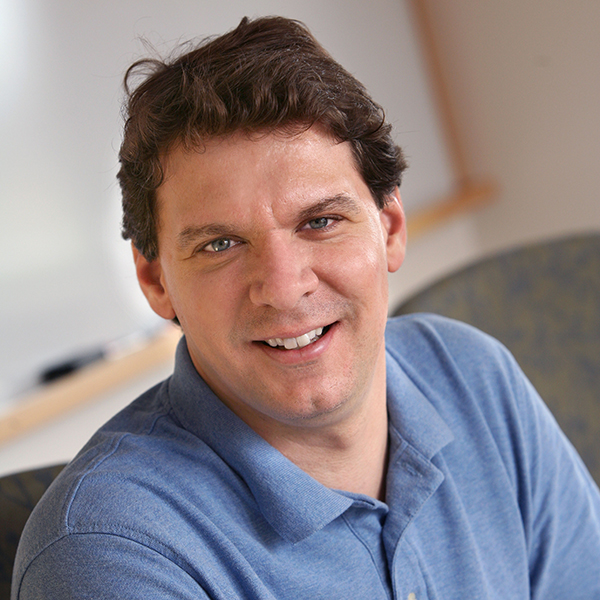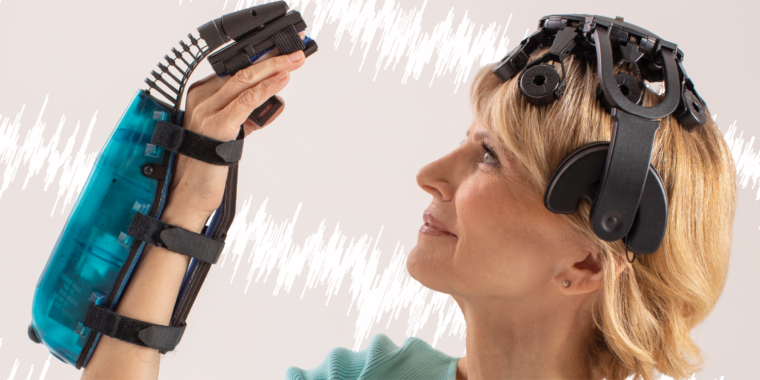Collaboration across disciplines is integral at WashU, often yielding life-changing discoveries. In 2002, when Eric Leuthardt, MD, and Dan Moran were introduced to each other by their department chairs, no one could have predicted it would lead to a collaboration that is reshaping the future of neuroscience.

Moran, professor of biomedical engineering at the McKelvey School of Engineering, was then a new faculty member; and Leuthardt, now a professor of neurosurgery, was a resident at the School of Medicine. What started as a mentorship quickly evolved into a research partnership and a lasting friendship.
“Collaboration is key,” Moran says. “Eric and I feed off each other, and then you get a gestalt. It’s not like, ‘Oh, you go do x, I’ll go do y, and we’ll put these two things together.’ It’s daily interactions and epiphanies.”
Leuthardt says he’s learned engineering principles from Moran, such as bioelectric phenomena in the brain and analytical analysis. “And as a neurosurgeon,” Leuthardt says, “I think I contribute to Dan’s insights when we think about clinical applications.”
This shared learning led the two researchers to their big idea, the IpsiHand, which makes movement possible again for patients debilitated by stroke. And that’s just the beginning. The device is also unlocking new possibilities in neurotechnology, including the reforging of neural networks once thought lost.
Developed through Neurolutions, the company Leuthardt and Moran co-founded in 2008, the IpsiHand is the first brain–computer interface to receive FDA approval for stroke, and the first FDA-approved thought-controlled device. “Other brain–computer interfaces can stimulate a part of the brain,” says Leuthardt, “but this is the first to decode a patient’s intentions.”

The idea for the IpsiHand, which the FDA green-lighted in April 2021, came out of a groundbreaking discovery. The brain has long been known to operate laterally, with one side of the brain controlling movement in the opposite side of the body. So, when a stroke injures the left side of the brain, motor control can be lost in the right side of the body. Leuthardt’s lab was the first to demonstrate that ipsilateral movement, where movement in one side of the body is controlled by the same side of the brain, could be achieved.
The breakthrough came as Leuthardt and Moran were studying motor movement in patients. “Historically, if you have an electrode array on one side of the brain, you have subjects do opposite-sided movements,” Leuthardt says. “But as a control, we said, ‘Let’s do movements on the same side,’ not expecting anything quite honestly. The first glimmer that something important was there came when my graduate student called and said, ‘We’re screening this patient, but it’s the strangest thing. We’re having them use the same-sided limb, and we’re seeing signal activations.’”
The discoveries cascaded from there. Leuthardt’s lab identified how those low-frequency ipsilateral signals could be encoded. And at Neurolutions, the next leap was the development, in collaboration with Oak Ridge National Laboratory, of an exoskeletal device — the IpsiHand — that fits over a patient’s hand and activates when those ipsilateral signals occur.
“When neurons fire together, they wire together. It’s a way to train the brain.”
Dan Moran
How does it work? The IpsiHand is not an aid to grip or hold things; instead, a grander idea is at play. When a patient who has lost movement in one side of the body uses the uninjured, same-sided part of the brain to think about, say, moving a finger, low-level ipsilateral neural signals occur, instantaneously activating the IpsiHand to move the finger for them. This produces a neural response from the finger that connects back to the brain’s original signal, forging a new neural network for movement. “When neurons fire together, they wire together,” Moran says. “It’s a way to train the brain.”
The invention’s success has been humbling, even poignant, for Leuthardt and Moran. A case in point is a firefighter who had lost movement due to stroke. After four years, he was well past the six-month threshold where motor recovery was believed possible. “He used our system,” says Leuthardt, “and after four weeks, he could put his pants on again by himself, which he hadn’t been able to do for four years. And he told me, and this still gets me a little choked up, that he wanted to hold his wife’s hand again — and now he can.”
Leuthardt and Moran’s big idea may lead to greater discoveries in the future. They’re applying what they’ve learned to spinal cord injury and ALS. They also hope to move from motor function — the most eminently decodable physiology — to brain–computer interfaces that treat psychiatric disorders such as depression. But even now, their discoveries are opening a brighter future for all of us, one patient at a time.



